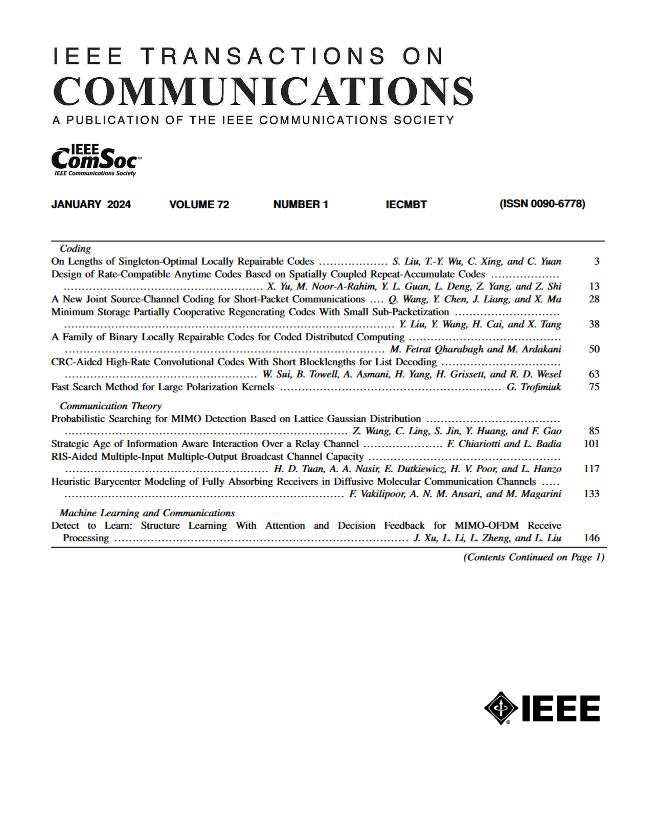空中可重构智能表面安全无线通信:性能分析与优化
IF 8.3
2区 计算机科学
Q1 ENGINEERING, ELECTRICAL & ELECTRONIC
引用次数: 0
摘要
将空中可重构智能表面(ARIS)与无人机(uav)集成为提高无线网络性能提供了重要机会。这种集成使ARIS能够安装在无人机上,提供更大的配置灵活性,建立可靠的空地连接,并实现三维信号反射。然而,这种集成也引入了与物理层安全性(PLS)相关的独特挑战。考虑到安全可靠通信的重要性,解决这些安全问题至关重要。本文研究了用于ARIS的PLS辅助无线通信系统。我们的目标是选择使所提出的系统模型的保密能力最大化的ARIS。考虑了两种选择方法,即最优和次优ARIS选择,并导出了Nakagami-m衰落信道上的保密中断概率和非零保密容量概率的解析表达式。此外,我们还研究了在实际场景中改变无人机数量和窃听者位置的影响。此外,还研究了协作方案,其中所有无人机合作以提高保密传输。每个ARIS在同一时频信道上反射发射信号的相同副本,没有相互干扰。提出了一种改进的粒子群优化方法,解决了在特定约束条件下无人机位置和RIS相移优化问题,使保密能力最大化。这些场景突出了ARIS在实现安全和高效无线通信方面的潜力。仿真结果验证了分析推导结果,突出了选择ARIS对提高保密性能的关键作用。仿真结果表明,将无人机数量增加一倍,平均保密率显著提高约77.78%。结果表明,该系统在提高无线通信PLS性能方面具有重要意义。本文章由计算机程序翻译,如有差异,请以英文原文为准。
Aerial Reconfigurable Intelligent Surfaces-Enabled Secured Wireless Communications: Performance Analysis and Optimization
Integrating aerial reconfigurable intelligent surfaces (ARIS) with unmanned aerial vehicles (UAVs) presents a significant opportunity to enhance the performance of wireless networks. This integration allows ARIS to be mounted on UAVs, providing greater configuration flexibility, establishing reliable air-ground connections, and enabling three-dimensional signal reflections. However, this integration also introduces unique challenges related to physical layer security (PLS). Addressing these security considerations is essential, given the significance of secure and reliable communication. In this paper, we investigate the PLS for ARIS to assist wireless communication systems. Our objective is to select the ARIS that maximizes the secrecy capacity of the proposed system model. Two selection approaches are considered, namely, optimal and sub-optimal ARIS selection, and analytical expressions for the secrecy outage probability and probability of non-zero secrecy capacity over Nakagami-m fading channels are derived. Additionally, we examine the impact of varying the number of UAVs and the locations of the eavesdropper in practical scenarios. Moreover, the collaborative scenario is investigated, where all UAVs cooperate to improve secrecy transmission. Each ARIS reflects identical copies of the transmitted signal on the same time-frequency channel without mutual interference. The optimization problem of UAV locations and RIS phase shifts to maximize the secrecy capacity under specific constraints is formulated and addressed using an improved particle swarm optimization technique. These scenarios highlight the potential of ARIS in achieving secure and efficient wireless communications. Simulation results verify the analytical derivations, highlighting the critical role of selecting the ARIS in enhancing secrecy performance. As revealed by simulations, doubling the number of UAVs leads to a notable improvement in the average secrecy rate by approximately 77.78%. The obtained results highlight the significance of the proposed ARIS-assisted system in enhancing the PLS for wireless communications.
求助全文
通过发布文献求助,成功后即可免费获取论文全文。
去求助
来源期刊

IEEE Transactions on Communications
工程技术-电信学
CiteScore
16.10
自引率
8.40%
发文量
528
审稿时长
4.1 months
期刊介绍:
The IEEE Transactions on Communications is dedicated to publishing high-quality manuscripts that showcase advancements in the state-of-the-art of telecommunications. Our scope encompasses all aspects of telecommunications, including telephone, telegraphy, facsimile, and television, facilitated by electromagnetic propagation methods such as radio, wire, aerial, underground, coaxial, and submarine cables, as well as waveguides, communication satellites, and lasers. We cover telecommunications in various settings, including marine, aeronautical, space, and fixed station services, addressing topics such as repeaters, radio relaying, signal storage, regeneration, error detection and correction, multiplexing, carrier techniques, communication switching systems, data communications, and communication theory. Join us in advancing the field of telecommunications through groundbreaking research and innovation.
 求助内容:
求助内容: 应助结果提醒方式:
应助结果提醒方式:


